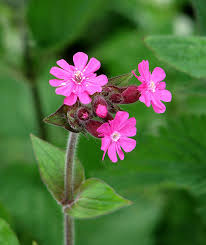|
From left to right- red campion, white campion and bladder campion. The Campions 'Come to the woods, for here is rest. There is no repose like that of the green deep woods.'
John Muir Common Name: Red Campion Latin : Silene diocia Family: Caryophllaceae History and/or use: A soap can be made from the roots. Wildlife Value: Nectar plant for bees, buterflies and hoverflies. A walk in the green woods in June reveals Silenus who is the Greek intoxicated God of woodlands that gives a home to the plant sucking nymph known as froghopper who encases herself in a protective foam. All of this of course is true for the sight I speak of is the gentle plant known as Silene (campion) the name of which is derived from Silenus the Greek God of the woods. The campions I write of have red and white flowers and also share the folk name of cuckoo flower with the plant called lady's smock ( Cardamine pratensis) which also houses the froghopper nymph, a common spring site on our British flora. Further folk names of the campion such as Robin Hood and adder's flower point to a plant which once was noticed and celebrated at a time when nature is brimming with the 'silent uprush of sap' to paraphrase the inspiring John Muir who continues to state that the sap rising and the storms of every sort 'are the orderly beauty-making love- beats of Nature's heart.' Campions can vary in colour from red to pink and white and once were used for snake venom as the above folk name indicates, their roots make soap and the juice of the plant was said to remove warts and corns. Please do not use this plant as used incorrectly it is incredibly toxic! The red campion is closely related to the white campion (S.latifolia) and when they grow together they readily hybridise unusually compared to other plant species, still remaining fertile thus disguising the original parents creating various shades of red, pink and white flowers. The other common species of campion is known as the bladder campion as it has an inflated calyx that resembles the bladder, its closest relative is the sea campion ( S.vulgaris) which also has the same distinctive calyx. You will find this species growing on cliffs and shingle distinguished by having larger scales on its petals than the bladder campion. The bladder campion exudes an evening scent but even for long-tongued invertebrates its nectar is hard to obtain which has led bumble bees to bite through the base of the flower to obtain the nectar. If you have enjoyed this article you may wish to sign up for our free newsletter which is packed with information on trees, plants and connecting with nature.
1 Comment
6/23/2020 04:38:15 pm
The different creations that we can see in the forest are all magnificent and they come in various shapes and sizes. I want to know more about the details of this post. The colors and the sizes of these flowers are all beautiful. I want to have one at home. I will take care of that flower and the whole family will be amazed by it. An additional collection of the different plants that we have at home.
Reply
Leave a Reply. |
Details
Poetry of flowersJoin me to explore the flora of the British Isles on this blog. My intention is to attempt to capture the unique quality and beauty of each species of flower, tree or shrub. For every species featured I will be growing many more wildflowers to celebrate the joy of their existence, their intrinsic conservation value and bewildering array of uses. For nearly 30 years I have noted, studied and explored wildflowers in the field much to the patience of the walker beside me. To share this passion is a heartfelt plea to respect, preserve and care for all British Wildflowers no matter how common they seem. Archives
February 2024
Categories |




 RSS Feed
RSS Feed
